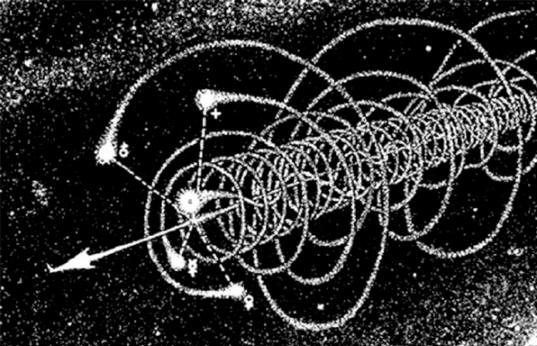|

The electrically charged Sun and its four inner
planets move through the galaxy.
From: A Little Book of Coincidence by John
Martineau.
Magnetic Storms
Jun 07, 2011
Strong magnetic disturbances are
usually observed when there are
bright aurorae.
In 1903, Kristian
Birkeland's Arctic expedition led
him to propose that the aurorae were
electrically energized by currents
flowing parallel to the formation.
Since electric currents flow in
closed circuits, and since the
auroral glow seemed to be caused by
processes in distant space, he
suggested that the currents travel
down from space at one end of the
arc and then back out to space at
the other end.
In 1973, the
U.S. Navy satellite Triad flew
through this electrically charged
layer. The onboard magnetometer
found two gigantic current sheets,
each carrying a million amperes or
more, one descending on the auroral
zone's morning side and one
ascending on the evening side.
Physical processes require an energy
input that can change from one form
to another. Consensus views also
suggest that this holds true for
geomagnetic, or auroral, substorms.
It is no accident, according to
scientists, that they take place
when the interplanetary magnetic
field (IMF) slants to the South. The
southern orientation, it is said,
means faster "reconnection" between
interplanetary and terrestrial field
lines, initiating rapid release of
magnetic fields and plasma from
Earth's sunlit side.
How this energy is released, as well
as what starts the process, are
still controversial subjects. Energy
in nature cannot be destroyed, as
the conservation of energy law
states; it changes from one form to
another. When electricity powers a
motor, it is converted to kinetic
energy. When friction stops motion,
the kinetic energy converts to heat.
Magnetic energy is also thought to
reappear in different forms. Some
becomes heat, increasing the
velocity of plasma ions and
electrons. Some of the energy ends
up driving electric currents in a
circuit linking the plasma sheet
with Earth.
Don Scott's commentary about
magnetic reconnection should be kept
in mind when reading reports from
NASA about Earth's interaction with
the plasma stream (commonly called
the solar wind) and electromagnetic
energy radiating from the Sun. He
notes that magnetic field lines are
only convenient ideas and nothing
more. They indicate a magnetic
field’s direction. Schematic
diagrams consisting of magnetic
field lines are useful for
visualizing its shape and strength,
although lines of force do not exist
in space anymore than lines of
latitude or longitude do.
Magnetic field lines do not move,
since the field is continuous.
Consensus opinions ignore that fact
and speak of field lines that can
move, touch, merge, and "detonate."
Scott's observation is that if this
idea were to be applied to circles
of longitude, they would come
together and "merge" in the polar
regions and could be theorized to be
the source of gravitational energy.
There is no such thing as "magnetic
merging" or "reconnection" of
magnetic field lines in the real
world. The energy comes from
electrical currents, which can move,
touch, merge, and detonate. The
cellular structure confining
electric currents in space is not
directly observable, except by
flying a space probe through them.
They have been detected on Earth and
in near-space.
Do we assume that the Solar System
is the only place in the Universe
where electric currents play an
active role? Electric Universe
advocates prefer to assume that the
space beyond our Solar System obeys
the same physical laws of plasma
interaction that are observed here.
Those laws are founded in
electricity.
Stephen Smith
 New
DVD New
DVD
The Lightning-Scarred
Planet Mars
A video documentary that could
change everything you thought you
knew about ancient times and
symbols. In this second episode of
Symbols of an Alien Sky, David
Talbott takes the viewer on an
odyssey across the surface of Mars.
Exploring feature after feature of
the planet, he finds that only
electric arcs could produce the
observed patterns. The high
resolution images reveal massive
channels and gouges, great mounds,
and crater chains, none finding an
explanation in traditional geology,
but all matching the scars from
electric discharge experiments in
the laboratory. (Approximately 85
minutes)
Video Selections
Order Link
|





 New
DVD
New
DVD

